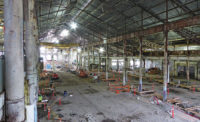After discovering asbestos in the structure's four elevator shafts, the team shut the cabs down, prompting Roy Anderson to revise its plans to take one elevator at a time out of circulation and use the remaining ones for material transport. Instead, the contractor added a two-cab material hoist to service the hotel and parking space, keeping it operational until demolition was complete and the hotel floors were stocked with required materials.
Given site and logistical constraints, precise planning and scheduling are paramount. "This job is just-in-time delivery to the definition," says Ferran. "With no lay-down space, deliveries go straight to the buck hoist and up to their appointed floor, where they are fed through windows," he says.
Logistics are further hampered by a city noise ordinance that precludes deliveries during off hours. As a result, a superintendent spends half his time coordinating delivery activities. "His tools aren't high tech—a cell phone and a printed matrix completed by hand," says Roy Anderson senior project manager Tom Abernathy. "Subs are required to coordinate among themselves and reserve the buck hoist for any deliveries requiring more than two trips."
Crews typically load materials into the building on Saturdays and Sundays, when fewer workers are on site. During any given morning, Roy Anderson gives elevator and buck hoist priority to crews not expecting deliveries so they can begin work as early as possible.
To maintain an aggressive time line, team members have executed major components—apartments, hotel, lobby parking and ramp—as independent projects, with crews working simultaneously on each. During peak periods, crews actively worked on nearly all floors.
In addition to accelerating the schedule, the five-in-one approach has proved advantageous once team members concluded that corresponding spaces were sufficiently complex to merit treatment as stand-alone projects, even if that approach occasionally challenges conventional sequencing.
"Ideally, we'd complete an entire floor, then move on, but in several instances we had to return to complete work on them," says Abernathy. "There's a balance between providing crews access to spaces and the number of rooms you take out at a time with the buck hoist."
To execute plans, Roy Anderson assigned superintendents to each of the five areas. Among other tasks, superintendents broke down the critical path method (CPM) schedule into matrices indicating floor and trade, then designated milestone dates to promote the orderly flow of work. "The approach was particularly beneficial to superintendents and foremen who weren't accustomed to reading CPM schedules," says Abernathy.








